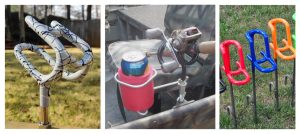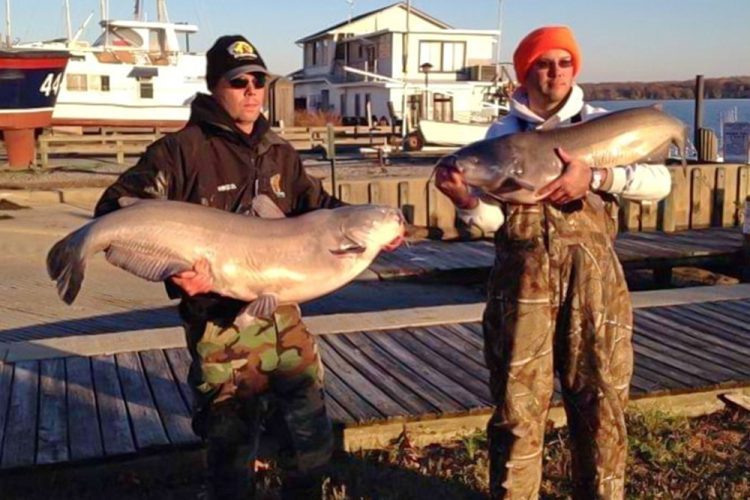The author and his long-time tournament partner Mike Dodge won the November 2013 Potomac River Monster Cats tournament with a combined two-fish weight of just over 114 pounds. The fish were caught with chunks of fresh cut-bait fished on large circle hooks—basic yet highly effective.
Choose the Right Gear for Rivers & Creeks
By Brad Hierstetter
On any given day, certain gear is better than others.
This month, I will discuss how to choose gear that is well-suited for scenarios you will commonly encounter while catfishing in rivers and creeks. This process can be likened to an individual who must choose from his or her toolbox the best tools to efficiently complete several tasks-at-hand.
Whenever you fish in current, from boat or shore, cast your baits downstream toward your target locations, then place your rods in stationary rod holders. Here, circle hooks will shine, but fishing them does take getting used to. Traditional snap-back hooksets are discouraged and will in fact result in lower hook-up ratios.
In waters with moderate to strong currents, the beauty of circle hooks lies in the fact that, when fished with the right rod, the fish all but hook themselves. A rod with a moderately soft tip is advantageous. This top flex, combined with the pressure created by the fish swimming away with a bait in its mouth, allows the point of the circle hook to rotate toward and pierce the corner of the fish’s mouth. Stiffer rod tips compete with the inherent design of circle hooks.

For catfish under 30 pounds, I prefer 7-foot, 6-inch Ugly Stik Striper Rods. For catfish over 30 pounds, I like Ugly Stik Tiger Rods, Berkley E-Cat Rods and Cat Fight Rods by Bottom Dwellers Tackle.
Today, quality rod holders can be obtained from multiple manufacturers. On my boats, I have found those made by Driftmaster and Fish Bite to be topnotch. Also, Tommy Hill (Hill’s Boat Rigging and Wire Forms on eBay) makes excellent rod holders that secure into a boats’ oar lock. For shore fishing, Smackdown’s bank rod holders are superb.
The overwhelming majority of trophy catfish anglers I know use casting reels when chasing 30-pound-plus catfish. (On the tidal Potomac and James Rivers, blue catfish at or well above 40 pounds are quite common). Still, choice of reels—casting or spinning, not to mention price range—is an issue of personal preference.
Active catfish are rarely, if at all, line shy. For catfish under 30 pounds, use 20- to 30-pound monofilament. This line rating is strong enough to haul in most of these fish, including those hooked in or near heavy cover, but also light enough to break without much difficulty should you get snagged. When fishing in trophy blue catfish tournaments on the Potomac River, in which individual fish weighing over 50 pounds are a regular occurrence, I opted for 60-pound monofilament. Regardless, I prefer Berkley Trilene Big Game Monofilament in colors I can easily see, such as Solar Collector and Blaze Orange.
Nowadays, because I only fish for fun and mostly target smaller catfish, I prefer the convenience of prefabricated 30-pound leaders, which I buy in bulk from eBay. These have a barrel swivel on one end, which effectively prevents line twist, and a snap on the other, to which I attach a 1/0 to 3/0 circle hook.
In big-cat tournament scenarios, I opted for an 80-pound monofilament leader, which I attached between a heavy barrel swivel and a 10/0 or 12/0 circle hook. I always used a Palomar knot to attach the hook to the barrel swivel because this is the knot I am most comfortable tying in daylight and darkness. You should also use the knot you are most comfortable tying.

Use shorter leaders, 6 to 9 inches, when fishing visible cover, such as downed trees and tree limbs, and longer leaders (18 to 36 inches) when fishing open water. If the cover you are fishing is especially heavy, forgo the leader entirely. If this heavy cover is in slower-moving current, replace the traditional lead slip sinker with a more snagless slinky weight, which is essentially a very narrow cloth sleeve into which individual weighted shot are inserted. Use a snap swivel to connect the slinky weight to your line, above a barrel swivel.
Sinker weight is another important, though often overlooked, enabling factor. On large waterways, pinpointing spots (while on the water) that are likely to hold active catfish takes considerable time, even when properly armed with the textbook knowledge to do so. Properly positioning a boat (especially if, like me, you like to anchor upriver from your spots) amidst strong currents is no easy task either, particularly in deep water where you may have to release 100 feet or more of anchor line. After expending this effort, the last thing you want is for your baits to drift away from your chosen location because your sinker is too light.
Winter being the exception, I typically fish water depths ranging from 10 feet to well over 30 feet (up to 80 feet), often in moderate to strong currents. On the mainstream Potomac, my tournament partner Mike Dodge and I always used 16-ounce lead slip sinkers. Overkill? Probably. Most of our fellow competitors typically used lighter 10- to 12-ounce sinkers. But these did all but guarantee our baits would remain where we wanted them to. Additionally, always place a plastic bead between the sinker and barrel swivel, if for no other reason because it will give your knot added protection.
In tidal waters, many anglers pull up their lines between tides. Instead, during slack tide, anchor directly on top of a spot that is likely to appeal to active catfish, such as a steep ledge, or drop-off, then cast multiple lines a short distance from the boat. By the time the baits settle, you will essentially be vertical fishing. Put your rods in rod holders and use this time to do things that will make the remainder of the day more manageable: grab a bite to eat, straighten up your boat, retie any lines that appear frayed, etc. My tournament partner and I have caught several blue catfish over 40 pounds doing this.
The topics discussed here, as well as in the article I wrote for the January 2024 issue of CatfishNow, comprise some of the basics all catfish anglers should strive to master. Always remember that small adjustments (in this case, related to gear), when factored collectively, typically go a long way to tilting the odds in favor of the catfish angler!
(In 2012 and 2013, Brad Hierstetter and his long-time friend Mike Dodge won two Potomac River Monster Cat tournaments on the tidal Potomac River. In addition to catfishing throughout Maryland, Hierstetter enjoys sharing fundamentals that can help any angler catch more catfish, regardless of when and where they fish



